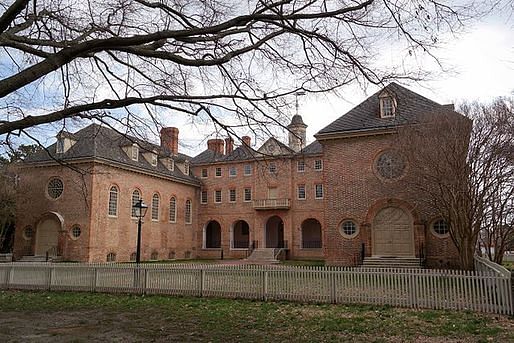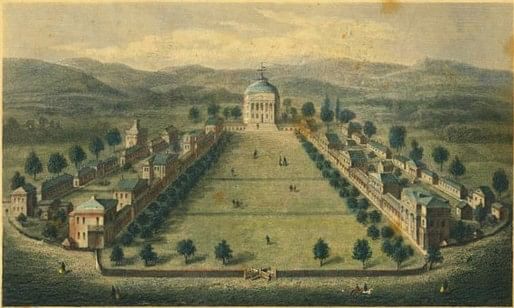

Click for full-size image
Our new series explores the history and future of university design. The first three installments detail key moments in university design history. The fourth and final installment discusses current trends in the field.
Last week, we took a look at three early universities that shaped the design of future institutions of higher education. This week, we'll compare two early American universities.
Williamsburg – 1693

 "To make, found and establish a certain place of universal study, or perpetual College of Divinity, Philosophy, Languages, and other good Arts and Sciences…” –The Court of William and Mary
"To make, found and establish a certain place of universal study, or perpetual College of Divinity, Philosophy, Languages, and other good Arts and Sciences…” –The Court of William and Mary
In 1693, Coregents William and Mary chartered this college, one of the New World’s first institution of higher learning.
Like English colleges, all of the functions of the College of William and Mary were housed in one building where students lived, studied, and attended religious services. The U-shaped building partially encloses a courtyard, which functions like a quad.
The single-building model remained influential: both Queen’s College (now Rutgers University) and The College of New Jersey (now Princeton) were built according to it.
Charlottesville – 1819

“Much observation and reflection on these institutions have long convinced me that the large and crowded buildings in which youths are pent up are equally unfriendly to health, to study, to manners, morals, and order.”-- Thomas Jefferson
Thomas Jefferson, educated at William and Mary, evidently did not enjoy being “pent up” in that “large and crowded building.” So, when he designed The University of Virginia, he envisioned a new model for education that he called the Academical Village.
Instead of a quad, Jefferson built his university around a rectangular Lawn. Each of the schools departments had its own pavilion which housed professor’s residences and classrooms. The pavilions themselves are designed in a Greek revival style. No two are alike, and together they display the full range of Greek architectural orders. At the northern tip of the Lawn is the university library – not, as one might expect, a chapel. The library, named the Rotunda, is one half scale replica of the Pantheon in Rome.
Jefferson believed that his buildings could be educational in-and-of-themselves. Students would develop good taste in architecture and a passion for democracy by observing the Greek style pavilions and the Pantheon-inspired Rotunda. The Lawn itself was designed to foster rich interactions between students and their professors.
Photo of College of William and Mary CC BY-SA 4.0 (http://creativecommons.org/licenses/by-sa/4.0)], via Wikimedia Commons
Exploring current design trends and their history.
1 Comment
"in 1963 coregents William and Mary..." Date typo. Also UVa was the world's first university not affiliated with a church.
Block this user
Are you sure you want to block this user and hide all related comments throughout the site?
Archinect
This is your first comment on Archinect. Your comment will be visible once approved.